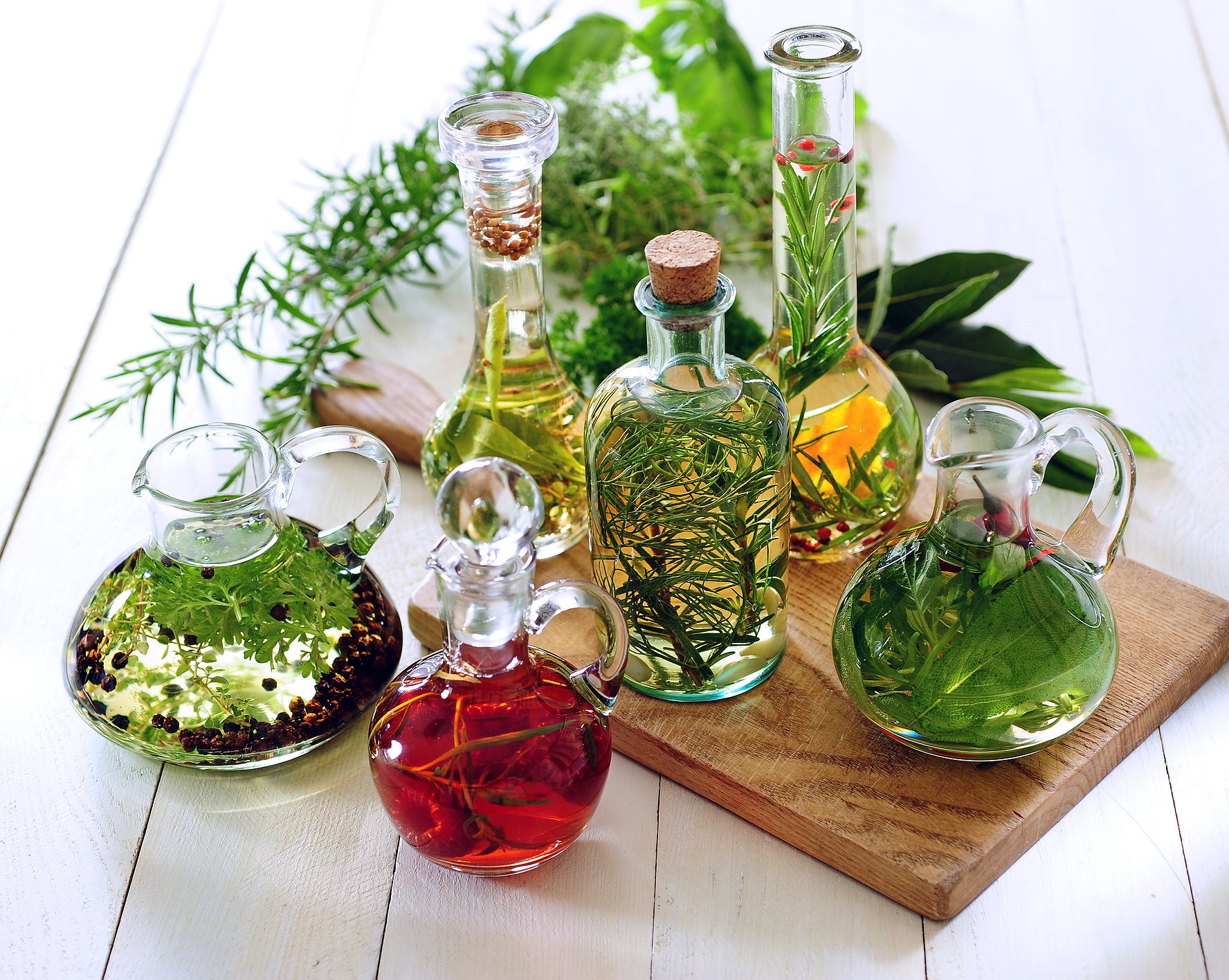Herb harvest shines in easy-to-make vinegars
Culinary herbs, fresh or dried, add such elegant piquancy to vinegars that I’m surprised more people don’t think of it. I often, after purchasing a simple vinegar, enhance it by poking a rosemary sprig into the bottle. It takes only a few days for the flavor to come on, making for a variety of salad possibilities.
A wonderful book from dear old friend Lois Wythe, has provided me with great tips for herbs used for special vinegars. Over the years, I’ve made many of them my own. A few of them follow for your consideration and individual herb supply.
• Chives — Excellent for a hint of onion; in season, the blossoms lend tang and a gorgeous pink color.
• Dill — Great in sauces for fish and or potato dishes, and as a marinade for large fish. Tuck a whole flower blossom into the vinegar bottle! Cider vinegar is the best bet.
• Mint — Best in white wine or cider vinegar for lamb, fruit salads and pea or green bean salads. Utilize the many varieties of mint to enhance individual dishes.
• Sage — Shines in marinades for meats and splashed lightly into a hearty veggie/meat stew. Red wine vinegar is best.
• Lavender — Prefers champagne or mild white or rice wine vinegar for fruit salads or sauces.
• Rosemary — Stands up to red wine vinegar best, but enhances good white wine vinegar as well. Perfect for hearty Italian or Greek dishes, salmon, and salads.
• Sweet Marjoram — Fragrant and heavenly in fruity salads or tossed with white beans or potato salad.
• Tarragon — Perfect for green salads, chicken dishes, and as a marinade for salmon steaks.
• Fennel — Exotic for fish dishes, grilled parsnips, and green salads.
Other possibilities include a few that have already faded, such as violets, elderflower, basil, nasturtium flowers and leaves. The first two should be treated as the lavender; the latter two in light white vinegars for drama via the whole nasturtium flower, and/or a gorgeous pink shade from Opal basil.
The easiest method for making your own herbal vinegar is to scald a quart canning jar and set aside with a few sprigs of your chosen herbs inside. Pour the purchased vinegar into a non-reactive saucepan and bring it just to the boiling point. Pour the hot vinegar over herbs in the jar and steep until cool or overnight. Discard wilted herbs. Strain cooled vinegar through cheesecloth in a funnel into the clean pretty bottle you have selected, which contains the prettiest sprigs/flowers of your chosen herb. Cork or cap (with a non-reactive cap) and let stand a few days or a week. I have had vinegars that lasted years, gaining flavor and mellowness just like wine! Old vinegars sometimes get a cloudy solution in the bottom of the jar; this is the “mother of vinegar” and doesn’t hurt a thing. Be gentle and don’t shake it up, however.
By the way, you can add other things to make your vinegar special. Citrus zest from lemon, orange or lime. Little hot peppers, seeds such as fennel, coriander, mustard, etc., and garlic cloves can play a role in a great mixture. Too, spices add a spark; think cinnamon sticks, cloves, bay leaves. Following are some ideas you can play with. Enjoy!
Rosemary Vinegar
4 fresh rosemary sprigs
3 cups of red wine vinegar OR white wine vinegar
1 perfect orange for zest (or lemon for a different tang)
Begin by washing a 3-cup bottle in hot soapy water, rinsing well in hot water and draining dry.
Carefully pare 6 orange zest strips into narrow ½-inch widths about 4 inches long, making sure not to retain any of the white pith on the strips. Rinse the rosemary sprigs and gently pat dry. In a small saucepan pour selected vinegar and warm over medium heat until hot.
Place the rosemary sprigs and zest into the hot bottle and with a funnel pour in the hot vinegar. Cover tightly and let stand at room temperature for 2 weeks for flavors to blend.
Provencal vinegar
1 sprig rosemary
1 sprig thyme
2 bay leaves
2 sprigs sweet marjoram
1 sprig lavender
2 garlic cloves
1 small hot red pepper
1 quart white wine vinegar
Follow basic instructions and use in a robust dressing for ripe tomatoes, eggplant dishes, or a meat marinade.
Zesty Dill Vinegar
1 small bunch dill, plus 1 or 2 blossoms
Zest of 1 lemon
1 garlic clove
1 tablespoon mustard seeds
1 quart white wine or cider vinegar.
Follow basic instructions and use it with fish or potato dishes, cucumbers, and salads.
As a final note, don’t purchase sharp or harsh vinegars as your base — white distilled vinegar takes much too long to “calm down” into a decent outcome. Also, don’t buy already seasoned vinegars, such as tarragon, etc.; go with basic red wine, white wine, mild rice wine, champagne or apple cider vinegars. Have fun!
Editor's note: For many years, Valle Novak wrote gardening and cooking columns for the Daily Bee. "Weekend Gardener" and "Country Chef" became renowned for their humor, information, and common-sense advice on how to do everything from planting to cooking. She left behind many columns such as this one from Sept.6, 2015, to delight her many fans.
 Culinary herbs, fresh or dried, add such elegant piquancy to vinegars, wrote Country Chef Valle Novak in this classic column from 2015. Using a variety of pretty bottles, adding various herbs to a simple vinegar, it takes only a few days for the flavor to develop, making for a variety of salad possibilities.
Culinary herbs, fresh or dried, add such elegant piquancy to vinegars, wrote Country Chef Valle Novak in this classic column from 2015. Using a variety of pretty bottles, adding various herbs to a simple vinegar, it takes only a few days for the flavor to develop, making for a variety of salad possibilities.

